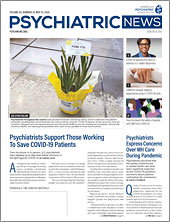Almost two-thirds of community behavioral health organizations (CBHOs) believe they can survive financially only for three months or less under the economic conditions resulting from the COVID-19 pandemic, according to an online survey.
The survey was conducted April 6 to 12 by the National Council for Behavioral Health and ndp | analytics, an economic and communications research firm. It included responses from 880 CBHOs located all over the United States and revealed that organizations have had to turn patients away, close programs, and generally reduce their operations as the economic realities of the current pandemic climate have set in.
Over 60% of CBHOs across the country have closed at least one program due to COVID-19, according to the survey, while 31% of organizations have canceled or rescheduled appointments or turned away patients. The impacts have been more severe for smaller organizations that serve 2,000 patients or fewer annually.
Nineteen percent of CBHOs believe they could survive only one month or less under the current COVID-19 conditions, the survey found. Only 9.4% of organizations believe they could survive a year or more.
Throughout the COVID-19 pandemic, APA has urged Congress to provide funding to behavioral health organizations.
“The COVID-19 pandemic could cause mental health care capacity to diminish across the country, just when communities need care the most,” said APA CEO and Medical Director Saul Levin, M.D., M.P.A. “If behavioral health organizations are forced to close, tens of thousands of patients will find themselves without necessary and life-saving mental health and addiction treatment.”
Losing access to care at CBHOs could force patients to turn to emergency departments (EDs) because they have nowhere else to go, which is not ideal in the era of COVID-19, pointed out Joe Parks, M.D., medical director of the National Council for Behavioral Health. People with mental illness have two to three times the rate of medical illness compared with the rest of the population, he said, as well as other risk factors that make them especially vulnerable to COVID-19.
CBHOs often serve as the vital link between patients with mental illness and primary care so they can get treatment for both their physical and mental illnesses. In addition to physical and mental health services, CBHOs also provide patients with community supports, from job training to housing services and food assistance.
CBHOs don’t just have an impact on patients, they also provide employment opportunities for providers and many other support staff in the community. In terms of the impact on employees, 46.7% of all CBHOs have had to, or plan to, lay off or furlough employees, according to the survey results. More furloughs and layoffs have taken place, or are planned, at organizations serving 8,000 patients or more.
CBHOs do not have regular or widespread use of personal protective equipment (PPE) normally, so most centers had limited PPE stock to begin with. But now, these CBHOs have also been dealing with a significant lack of PPE, with 82.9% reporting that they don’t have enough PPE for two months of operations.
“Behavioral health organizations need equal priority with the rest of health care,” Parks said. Just like other health facilities, CBHOs need access to PPE and testing capabilities so they can provide in-person care when necessary, and they need to be reimbursed for telemedicine services when in-person care is not an option, or is easier and clinically appropriate. “If we want our EDs to function well, we need our behavioral workforce to be strong throughout this pandemic,” he said.
Parks said there will likely be a surge of need for mental health services soon, as the country reels from the economic and social impacts of the pandemic. “We should anticipate the next surge and ensure we have the mental health capacity and workforce to meet the need.
“We need to get our priorities straight,” he added. ■
“COVID-19 Economic Impact on Behavioral Health Organizations” is posted
here.

